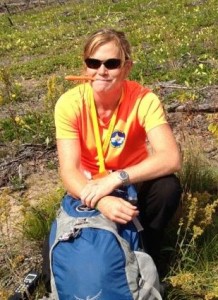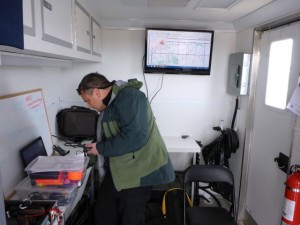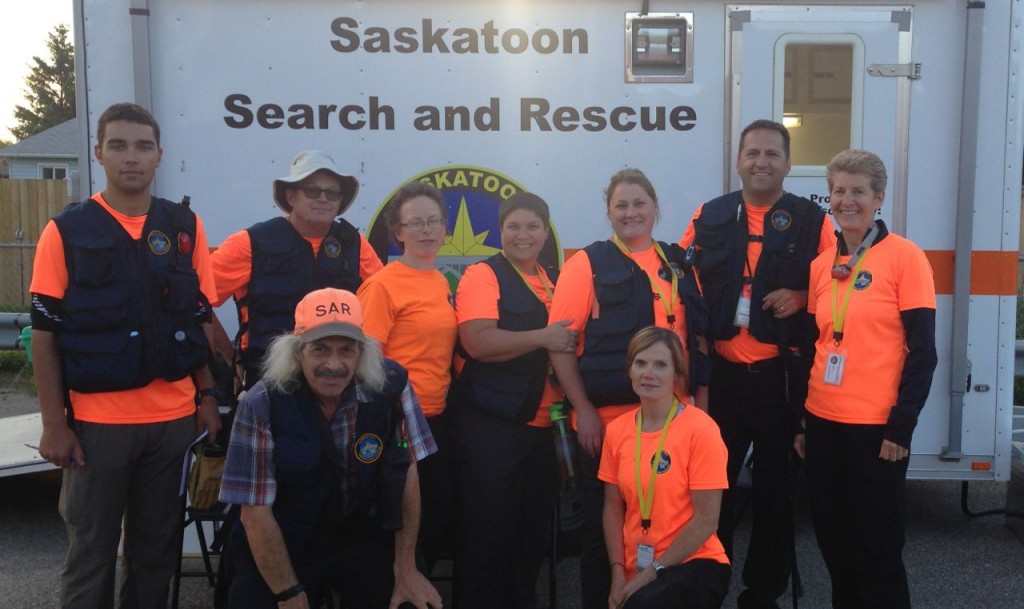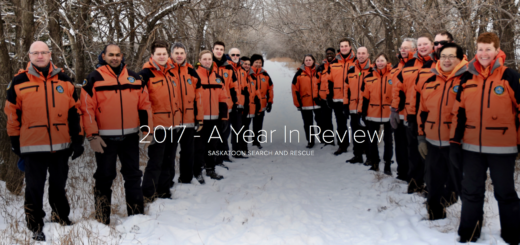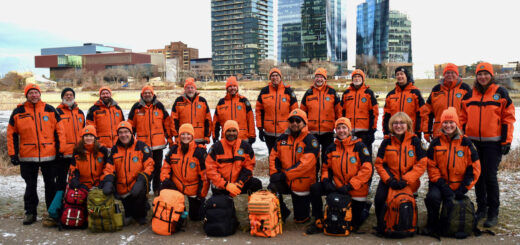The Anatomy of a Search Activation
The text tone on my phone sounds at 1:45 am. Without looking, I know it’s a message from Rebecca. She’s the main keeper of the callout list for Saskatoon Search and Rescue and the only person in my contact list for whom I have an audible alert tone.
“SPS Activation 0145hrs: 75 yr old male. Missing since 1900 hrs. Dementia, other med concerns. Meet pkg lot Greystone Hts School, 2700 Main St. Available?”
Our Search Manager, Jeff, has received a phone call from the Saskatoon Police Service Watch Commander requesting our help. After getting all the details and confirming we can be of assistance, he calls Rebecca to send out an activation notice.
By the time I look at the text and walk out of the bedroom to send a response, my husband has rolled over and gone back to sleep. I spent 25 years as an officer with the Saskatoon Police Service, often working odd shifts and being on call. He’s used to the phone ringing in the middle of the night and finding a note on the kitchen table in the morning letting him know where I am.
Other members will be explaining the situation to their spouses and figuring out childcare in case they’re not back before “normal” wake up time.
I pull on my favorite pair of black pants (the ones with the side pockets big enough to carry my cell phone, reading glasses, notebook and pen) and a long-sleeved black shirt with my bright orange SSAR t-shirt over top. I grab a fleece and orange Arc’teryx jacket out of the closet. Layers are good. It’s cold out now but will warm up once the sun comes up.
My backpack is already packed (compass, GPS, first aid kit, small tarp, hiking poles, headlamp, energy bars, trail mix and other essentials). I fill my water bottle and slap together a peanut butter sandwich. Who knows when we’ll get home. Oh, must not forget veggies. Very jealous last callout when I saw Rebecca eating carrots! Lucky for me, she shared.
Given the time of day, Rebecca will be phoning those who haven’t answered the text. She’s having trouble finding an available member with a vehicle capable of towing the command trailer to the staging area. Rod agrees to pick it up and drop it off, but he can’t stay. He’s got an early and busy workday ahead. With new twin babies at home, Dale can’t come now either, but he agrees to pick up the trailer when we’re done.
Forty minutes later I arrive at scene. Jeff, is already there, getting more details from Saskatoon Police Sergeant Patrick Barbar and planning our course of action. Sgt. Barbar will be our liaison with other SPS members and act as Incident Commander.
I get the sign-in sheet started and others straggle in over the next few minutes. Kent has printed out copies of the missing person description form with a photograph of our subject from the SPS media release and starts handing them out. Henry is the last to arrive, but he gets out of his car with a large box container of Tim’s coffee in one hand and a stack of paper cups, sugar packets, creamer and stir stix in the other. If only momentarily, he’s everyone’s hero.
I quickly pull up the “cheat notes” I’ve got on my iPhone to refresh my memory of lost person behavior characteristics of someone with dementia. “Direction of travel is a good predictor of where they are found. They’re oriented to the past and may try to return to a former residence or workplace. They’re often recognized by the public due to inappropriate dress, unsafe or inappropriate behavior. In an urban environment, they’re typically found in structures or walking along roads.” **
Tonight (okay, this morning!) we’ve got 12 members out. A good turnout for the middle of the night on a weekday.
We gather around the command post and Jeff provides us with an update. A full description of “Fred,” time and point last seen, past history and any other details he has. Unfortunately, we don’t have a direction of travel since no one saw Fred leave his house.
The police have already done a lot of investigation. They’ve contacted hospitals, ambulance, fire, transit, taxis to be on the lookout for Fred. They’ve checked known locations, family, friends and put out a media release that also goes out on their Facebook and Twitter feeds. As SSAR Communications Director, I “share,” “re-tweet” and let the public know our members are out searching too. Search is an emergency and the more people who know we’re looking for someone, the higher the chance of success.
Jeff assigns the Team Leaders and divides us into groups of three. I get the task assignment for my team and meet with Rick and Sherry. I’ll look after communications; Sherry will be our scribe; Rick is a First Responder so he’s responsible for first aid. I make sure everyone’s got the gear they need and talk about some of the hazards we might face. The weather is fine now but rain is in the forecast. Visibility at night is always a concern and we’ll have to be aware of slips, trips and falls especially in the alleys and parks. The safety of searchers is key. Check-in times with the command post are set for every 30 minutes.
We review our task, look at a map and plan our strategy. The initial step of almost every search is to cover a 300m radius from the point last seen. We’ve been assigned to search streets and alleys in one section of this area. It takes us a couple of hours to complete our assignment and we return to the command post where I write up a debrief report outlining exactly where we searched, what we found (if anything) and what might need to be looked at further. We quickly re-fuel and top up water bottles before heading out on our next task. That peanut butter sandwich keeps me going.
Several hours later, the sun is starting to come up and it’s a reasonable time to start knocking on doors, asking people if they’ve seen Fred and if we can check for him in their yard and out-buildings.
Some of our members have to leave for work commitments, others are checking in with family and phoning their employers to see if they can take some time off in order to continue searching.
Back at the command post, SPS dispatch calls Sgt. Barbar on the radio. Good news! An alert transit driver doing his first run of the day has recognized Fred from the social media feeds that have been going out all night. They send another police unit and an ambulance to Fred’s location. He’s tired and confused but none the worse for wear. As best they can figure out, Fred has spent the night trying to get to a house where his oldest son and family lived five years ago.
We happily head back to the command post. Regardless of how or where or by whom a subject is found, it’s always a win. Especially when they go home safe to their family.
With smiles on our faces, we pack things up, clean up the command post, sign out and head home. Jeff, as the Search Manager, still has some final paperwork to do but that can wait until tomorrow.
Written by Shelley Ballard-McKinlay
Editor’s Note: Although this is a fictional scenario, it is representative of a “typical” SSAR activation (if there is such a thing), some of the challenges we face and the level of training required. Most of the actions of our members really did occur and Sgt. Barbar has been our liaison on several searches.
** From Lost Person Behavior: A Search and Rescue Guide on Where to Look — for Land, Air and Water by Robert J. Koester
